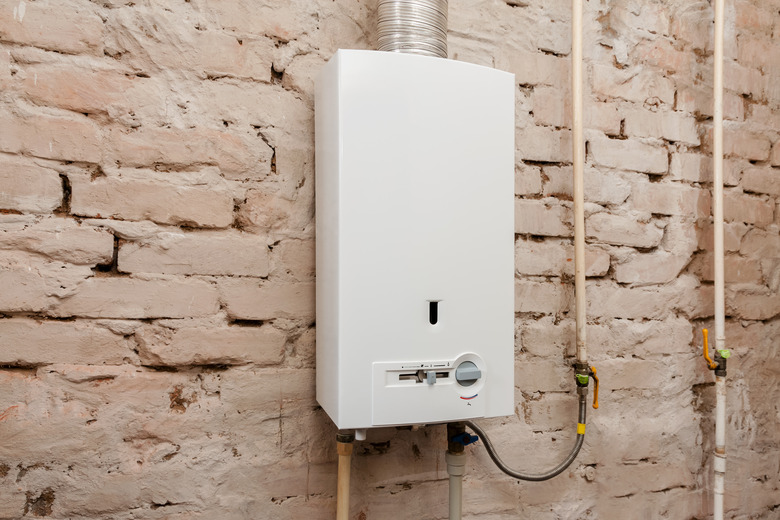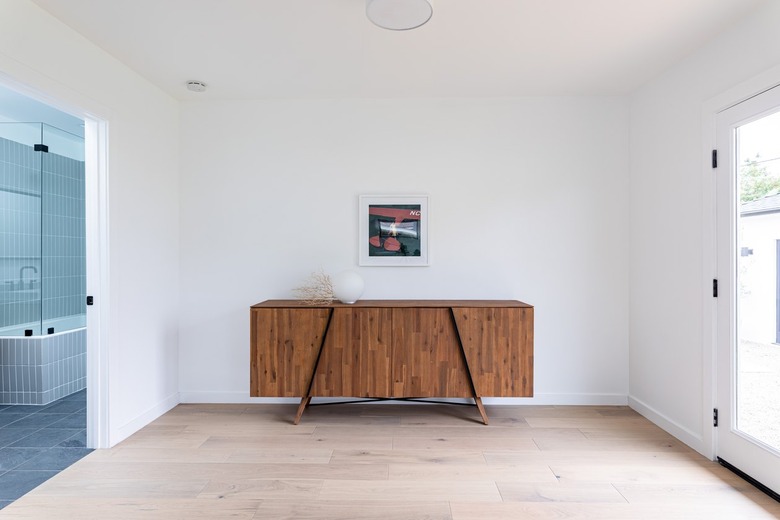How Much Does It Cost To Install Radiant Flooring? Here's A Detailed Breakdown
We may receive a commission on purchases made from links.
Whether you prefer hardwood flooring, tile or carpet, nothing upgrades a floor quite like installing a floor heating system — but, of course, those toasty floors come at a cost. Before you install heated floors (or radiant flooring, as it's referred to in the building industry), you'll want to know all the factors that determine the radiant floor heating cost so you can budget for it.
Right up front, you need to know the following:
- The square footage the system will cover
- The type of flooring you want after the system has been installed
- Whether or not you want hydronic (hot water-based heat) or electric radiant heat
One thing you won't have to consider is ductwork — because a radiant floor heating system doesn't need it. Unlike forced-air systems, radiant floor heat does not require HVAC equipment, such as blowers and filters, which is a big part of its attraction. The main cost determinant for radiant flooring, however, is figuring out whether you want the floor heating system to be a main source of heat in the entire home (best suited for hydronic systems) or if you just want to add it to small areas for more comfort (best for electric systems).
Tip
Total radiant floor heating costs depend on factors such as the square footage and the choice of floor covering, but you can expect to pay an average of $8 to $15 per square foot to install electric heating elements in your floor and between $3 to $20 per square foot for installing hydronic heating. This doesn't include the additional costs of the boiler (for hydronic systems) or the additional floor covering you'll need once the radiant flooring is installed.
Radiant Floor Heating Cost: An Overview
Radiant Floor Heating Cost: An Overview
If you're early in the planning process, you'll want to know the average cost associated with installing a radiant floor heating system so you can make a decision about whether or not it fits your budget. As you might expect, the final cost depends on your choice of materials and the installer or contractor with whom you work. A tip: Don't bypass the contractor unless you're planning to install electric heat in a single room; whole-house installation of hydronic or electric floor heat is not a DIY project.
On average, you should expect to pay from $8 to $15 per square foot to install electric heating elements in your floor. The average cost for installing hydronic heating is a range between $6 and $20 per square foot, although there are also quotes with much smaller numbers ranging from $3 to $7 per square foot.
Some Additional Costs to Consider
Some Additional Costs to Consider
If you're planning on installing hydronic radiant floor heat, you'll need to also purchase and install a boiler. Like furnaces, boilers that operate at various efficiency levels are available, and if you opt for a high-efficiency model, you'll pay extra for it, but you'll make that up in lower operating costs over the years. If you already have a system of hydronic radiators that uses a boiler, it's a good idea to replace it because modern boilers, even standard-efficiency ones, are significantly more efficient than older ones. Boilers don't last forever, and an old one that serviced a radiator system is probably more or less done for anyway.
Hydronic radiant heat systems can be designed with varying degrees of sophistication, ranging from a simple system that heats the entire house to the same temperature to a multizone system that can heat each room to a different temperature. The same multizone capability is available with electric radiant floor heating, but electric heating costs more to operate and doesn't heat entire rooms as efficiently as a hydronic system. The initial radiant floor heating cost is bound to be less when the system is electric because you don't need a boiler, and electric radiant heat is probably a better choice if your goal is simply to make your bathroom and bedroom floors more comfortable in the coldest months of the winter.
The Basics of Installing Hydronic Floor Heat
The Basics of Installing Hydronic Floor Heat
The basic procedure of a radiant floor heating system installation is laying heating pipes in the floor or underneath it. There are both wet and dry installations. In a wet installation, PEX tubing is laid on a solid subfloor, which can be wood or concrete, and embedded in thinset mortar or floor leveling compound, which is then covered with the flooring material of choice. In one version of a dry installation, tubing is stapled to the underside of the subfloor or threaded through holes drilled in the joists, and in another version, a grooved board system is installed on top of the subfloor, and the tubing is laid in the grooves.
After installing the tubing for a hydronic system in the floor, you connect it to a boiler and install one or more in-line circulation pumps to keep the hot water circulating. A multizone system also needs a manifold — usually located near the boiler — to divide the main hot water line into zones. You typically provide each zone with its own thermostat so you can regulate temperature in individual rooms independently.
Cost of the Boiler and Circulation Pump
Cost of the Boiler and Circulation Pump
Boilers — necessary for hydronic radiant flooring — can be gas- or oil-fired, and the better choice often depends on where you live and the utility services available. Here are the most important cost factors to consider:
- Standard-efficiency gas boilers typically cost from $2,400 to $3,000, and the cost of an oil-fired boiler is comparable.
- Installation costs vary and are higher for high-efficiency models, which for gas boilers means an AFUE between 90 and 99 percent and for oil boilers, above 90 percent.
- It costs between $2,500 and $3,000 to install a standard-efficiency gas boiler and between $3,000 and $6,500 to install a standard-efficiency oil boiler.
- If you opt for a high-efficiency model, installation costs will range from $6,000 to $9,000 for both types. A boiler can double as a water heater, which is a bonus that makes it more cost effective.
Neither the circulation pump nor manifold adds significantly to the overall cost of a radiant floor heating system, however. A circulation pump can run from $100 to $400 depending on the horsepower, and the range of manifold prices is about the same depending on the number of zones. Installation of these components adds little to the overall cost of installation of the underfloor tubing.
Hydronic Radiant Floor Installation Costs and Methods
Hydronic Radiant Floor Installation Costs and Methods
If you're pouring a concrete slab as part of new construction, you're in luck because that makes installation of the tubing for hydronic systems easier and less expensive. The process involves laying a reflective barrier on the ground, laying the tubing and pouring the concrete. Instead of laying 2- or 3-inch rigid foam insulation board (about $2 per square foot), you can opt for a product such as Crete-Heat, which costs twice as much, but it significantly reduces installation time and costs. Either way, you'll also need several hundred feet of PEX tubing, which costs about 20 cents per foot.
If you're doing a retrofit on an existing floor, the simplest method is to staple the tubing to the underside of the subfloor, and when you do this, the addition of heat transfer plates is recommended, with each one costing $1.30. You'll also need to staple a reflective barrier to the bottom of the joists under the tubing, which costs about 10 cents per square foot.
If you're doing a room remodel that involves replacing the floor covering (or you don't have access to the underside of the floor), the best installation method is to lay pre-grooved boards to hold the PEX tubing. These boards often come with an aluminum coating for better heat transfer, but at $8 to $10 per square foot, they are expensive. You can DIY a comparable system by cutting 3/4-inch plywood into 12-inch strips and laying them close enough together to allow the tubing to fit between them, which reduces the cost to about $3 per square foot. You'll need to install your own heat transfer plates, which adds about 54 cents per linear foot to the cost.
The Basics of Installing Electric Floor Heat
The Basics of Installing Electric Floor Heat
When the floor is electric, you're installing electric heating elements rather than tubing under the floor. You can do this in all the same ways you use to install tubing, although it's often easier to install mesh mats to which the elements are already attached. Some mats are designed to go directly under laminate and vinyl floating floors, and some are designed to be embedded in thinset. When installing these types of mats or heating cable, you typically hardwire them to the home's circuitry. An electric system is typically controlled by a thermostat connected to a sensor installed in the floor along with the heating elements.
Electric Radiant Floor Installation Cost
Electric Radiant Floor Installation Cost
Homeowners who just want more comfortable bedroom or bathroom floors will generally choose electric systems, which don't require installation of a boiler. The two most common installation methods are to fix cables to the subfloor and embed them in thinset, which costs from $5 to $15 per square foot including fixing strips, or to lay mats with heating cable embedded in them, which costs from $10 to $12 per square foot. Mats are designed to be cut into sections that can be laid next to each other or arranged to form corners and angles, and although both mats and cables should be laid on a reflective barrier, heat transfer plates aren't usually required. You may need to hire an electrician to hook the heating elements to power.
Choosing a Good Floor Covering
Choosing a Good Floor Covering
Heated floors depend on convection to radiate heat, so the floor covering should have good heat transfer properties, and it should be able to withstand the heat without degrading. Concrete fits the bill, and when laying radiant flooring in a concrete slab, many homeowners choose to leave the slab uncovered and paint it or dye and polish it, which is the most economical way to finish the floor. Apart from that, a ceramic tile floor covering is the most popular choice for radiant floor heating.
Wood flooring products, such as engineered and solid hardwood, and composites, such as laminate, have good heat transfer properties, but they can be damaged by the persistent high heat of a radiant flooring system. Planks may curl or separate, particularly solid hardwood, which isn't as structurally stable as its engineered counterpart. These products should be used in conjunction with a temperature sensor and programmable thermostat that prevents the temperature from rising higher than the manufacturer's safe limit for the product you use, which is usually between 80 and 90 degrees Fahrenheit.
Vinyl and linoleum are also suitable coverings for a radiant floor, and installing them can help keep labor costs to a minimum but avoid luxury tiles with heavily insulated backing because it won't allow the heat to pass freely. This is also true for laminate, and it's especially true for carpeting, which is generally a poor choice for a radiant floor unless the pile is very thin — typically 3/4 inch or less. On the other hand, if you installed electric radiant heat in a single room just to make the floor more comfortable and you aren't worried about heating the room because you have an alternative heat source, heated carpet can feel positively luxurious.

